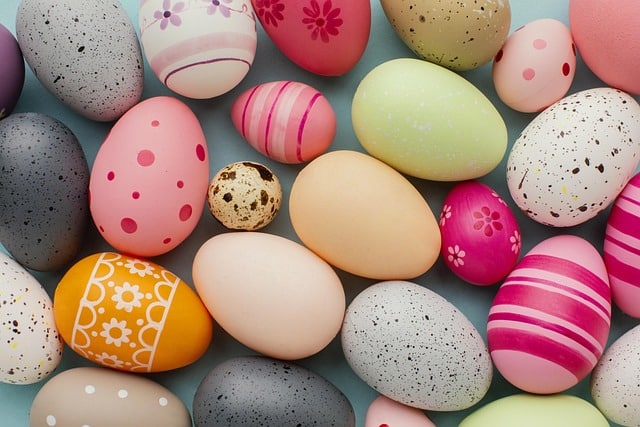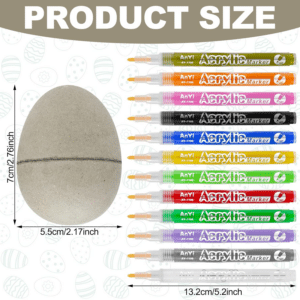[Update 03/06/2024: We added the concept of a community easter egg garden and replaced the cardboard egg idea with a paper mache egg.]
Introduction – Sustainable Easter
When Easter comes around each year, kids prepare for a day of toys and treats! While some adults still enjoy Easter egg hunts, the holiday doesn’t have as much meaning to them.
Easter eggs are a fun and festive addition to any holiday celebration, but have you ever stopped to think about what happens to the plastic ones after they’re used? The answer is, unfortunately, not much.
These plastic eggs have two problems.

First they’re made from fossil fuels as are all plastics and require energy, therefore incurring a carbon cost from the fossil fuel extracted and from the production.
Second, during the landfill decomposition process they will contribute to carbon dioxide and methane decay emissions. But there are two solutions – recyclable Easter eggs and compostable Easter eggs. In this article we’ll talk about compostable choices.
These can be made from biodegradable materials such as paper or plant-based plastics; you can toss these eggs into your backyard compost pile or municipal green bin after use. Not only does this help keep plastic out of landfills and oceans, but it also aids in creating nutrient-rich soil for gardens or lawns.
Why Should We Celebrate A Sustainable Easter?
Easter is a time for celebrating new life and renewing our connections with loved ones and the natural world around us. However, in our consumer-driven society, we often forget to consider the environmental impact of our holiday choices.
By making sustainable choices during Easter celebrations, we can reduce unnecessary waste and protect the earth for future generations.

From opting for reusable baskets and decorating with potted plants instead of plastic grass to purchasing Fair Trade chocolate eggs and supporting local farmers’ markets for Easter meals, there are endless ways to celebrate this holiday sustainably.
Why not start a new tradition this year by incorporating eco-friendly practices into your Easter celebration? Not only will you be helping to preserve the environment, but you’ll also be teaching important values to your children and setting a positive example for your community.
7 Compostable Easter Eggs
Every year when Easter rolls around, kids get excited about all the candy and toys that come with it. While many adults still enjoy participating in egg hunts, they may not think much about the environmental impact of all this plastic waste.
Compostable Easter eggs are a great solution to this problem. Here are 7 compostable Easter eggs you can choose from:
1. Paper Eggs
Paper eggs are made from recycled materials; these eggs are a great eco-friendly option for Easter. They’re easy to color and decorate, so kids will have fun picking out their favorite colors and decorations for their egg hunt activities. You can make them with crayons or markers or even get creative with paints and stickers.
First, gather some colorful scrapbook paper and scissors. Second, fold each piece of paper in half. Cut an egg shape along the folded edge, then unfold it to reveal your creation. Third, using a glue stick or double-sided tape, adhere the two sides of the egg together to create a hollow shell. Fourth and finally, decorate your eggs with markers or glitter and fill them with treats or small trinkets for a fun Easter surprise!
Make sure the paper you use does not contain plastics. If you’re unsure, use the finger nail test. Apply pressure on the paper with a finger nail and drag your nail across the paper. If the paper changes color then its got plastics in it. Composting a plastic-based paper will leave chemicals in your compost.
2. Plant-Based Plastic Eggs
Made from plant-based plastics such as cornstarch, these eggs are a great option for those looking for an environmentally friendly alternative to traditional plastic Easter eggs.
They’re durable and will hold up to all the egg hunting, but can easily be composted when you’re done with them – no lengthy decomposition process required. But even more importantly, no use of fossil fuels to create products.
3. Paper Mache Eggs
If you’re looking for an even more eco-friendly option, look no further than paper mache Easter eggs.

One example is the 36 Pcs DIY Paper Mache Easter Eggs set. Priced at $22.99, the kit provides 24 paper mache eggs and 12 color markers, offering ample materials for a wide range of decorative ideas and patterns. The eggs, measuring approximately 2.8 x 2.1 inches, are small, cute, and made from lightweight paper, making them easy to handle and display in various settings.
4. Natural Fiber Eggs
There are two types we can think of. The first type, natural fiber eggs are made from eco-friendly materials like tree bark or banana leaves. These eggs are a great alternative for those who want to keep plastic out of landfills and oceans.
They’re durable enough for egg hunts but can easily be composted when you’re done with them. They come in various colors and patterns for added fun and creativity.
The second type are traditional cloth fibers like wool. Check out these 100% wool felt eggs. Other cloth fibers are cotton, jute, or linen. You can use either pre-made fabric Easter eggs, or make your own using fabric and a needle and thread.
Begin by cutting two identical shapes out of the fabric of your choice, then sew them together with a small stitch around the edge, leaving a small opening. Stuff the egg with batting or stuffing, then sew the opening shut. You can decorate the eggs with buttons, ribbons, or paint.
5. Recycled Paper Eggs
If you’re looking for an affordable option that keeps plastic waste out of landfills and oceans, recycled paper Easter eggs might be perfect. These cute little treats are easy to color or decorate with stickers and can even be printed with your favorite Easter designs!
Simply gather some colored paper and get crafting with your kids for a fun holiday activity. This isn’t our top choice though because it doesn’t truly get around the problem of plastics in the first place.
6. Natural Dye Easter Eggs
Looking to go a little more eco-friendly this year? Why not ditch the artificial dyes and try some natural-dye Easter eggs instead? Made from materials such as turmeric, beet juice, or blueberries, these eggs are a beautiful way to celebrate the season without adding harmful chemicals to your child’s diet or our environment.
They’re also super easy to make – simply boil chopped-up foods like beets or blueberries in water until they reach the desired color and place them on hard-boiled eggs overnight.
7. Edible Egg Shells
For a truly unique compostable Easter egg experience, try making edible egg shells! There are various ways to make these edible treats – you can hard boil chicken eggs and then cover them in melted chocolate or cocoa butter, or you can even use an egg mold to shape your egg-shaped filling like banana creme or ice cream.
Roll the eggs in sprinkles or mini M&Ms to finish it off for even more fun! With so many options, there’s something for everyone regarding compostable Easter eggs this year.
What We Don’t Recommend – Wood Easter Eggs
Some of you might think that you can get wood easter eggs as an eco-friendly alternative to plastic eggs. However, wood easter eggs, unless you know the manufacturer well, may very well come from non-farmed tree sources, leading to deforestation.
This is a common problem with wooden products, and why wooden Easter eggs are not considered an eco-friendly option. To avoid the problem? Find out if the wood is sourced responsibly and sustainably.
Community Easter Egg Garden – Cut Waste And Improve Gardens
Instead of traditional Easter egg hunts, communities can come together to create Easter Egg Gardens. These gardens can be filled with eco-friendly, compostable Easter eggs, hidden among real plants and flowers.
After the Easter egg hunt, participants can plant new flowers or vegetables in the same space, utilizing the compostable eggs as part of the planting process. This not only adds a new layer to the Easter celebration but also educates children and adults alike about gardening, composting, and the importance of community in environmental stewardship.
The gardens can be a communal effort where each family contributes compostable eggs and plants. This activity not only minimizes the environmental impact of Easter celebrations but also promotes local biodiversity and teaches children about the life cycle of plants and the importance of caring for the environment.
The Benefits Of Using Compostable Easter Eggs
You may fill the traditional Easter egg with chocolatey goodness, but it also has a hefty environmental cost through production emissions and decay emissions. Most plastic and foil Easter eggs are not recyclable and end up in landfills.
But that doesn’t mean you have to sacrifice fun for sustainability – by opting for compostable Easter eggs, you can still enjoy the tradition without impacting the environment.
Compostable Easter eggs are made from plant materials such as sugarcane or wood pulp and will break down in a compost bin instead of lingering in a landfill for years.
Plus, using compostable eggs is not just beneficial for the environment – it also helps your garden! The decomposing eggs provide nutrients for plants and can help enhance soil structure. So this Easter, consider switching to compostable eggs to reduce your holiday’s impact on the planet.
In the same spirit, make your compostable easter eggs part of an eco-friendly easter basket.
Conclusions
Looking for a way to make Easter more eco-friendly this year? Consider choosing one of the many compostable Easter eggs on the market today.
Whether you choose paper, a plant-based plastic, cardboard, natural fibers, recycled paper, or edible egg shells, there’s sure to be a perfect option for your family. So what are you waiting for? Get out there and start crafting today!
